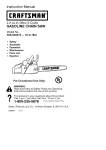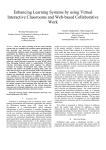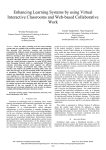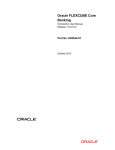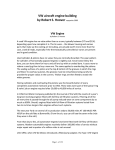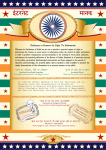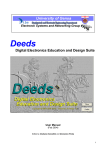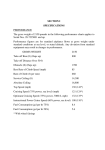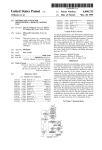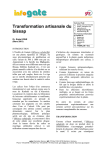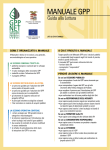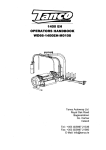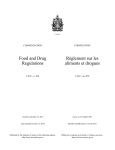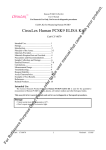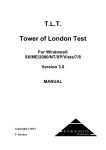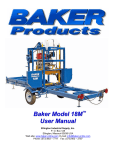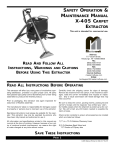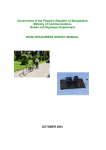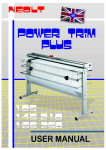Download IS 7032-1 to 8 (1986): Physical methods of test for uncut Indian jute
Transcript
इंटरनेट मानक Disclosure to Promote the Right To Information Whereas the Parliament of India has set out to provide a practical regime of right to information for citizens to secure access to information under the control of public authorities, in order to promote transparency and accountability in the working of every public authority, and whereas the attached publication of the Bureau of Indian Standards is of particular interest to the public, particularly disadvantaged communities and those engaged in the pursuit of education and knowledge, the attached public safety standard is made available to promote the timely dissemination of this information in an accurate manner to the public. “जान1 का अ+धकार, जी1 का अ+धकार” “प0रा1 को छोड न' 5 तरफ” “The Right to Information, The Right to Live” “Step Out From the Old to the New” Mazdoor Kisan Shakti Sangathan Jawaharlal Nehru IS 7032-1 to 8 (1986): Physical methods of test for uncut Indian jute, Mesta and Bimli [TXD 1: Physical Methods of Tests] “!ान $ एक न' भारत का +नम-ण” Satyanarayan Gangaram Pitroda “Invent a New India Using Knowledge” “!ान एक ऐसा खजाना > जो कभी च0राया नहB जा सकता ह” है” ह Bhartṛhari—Nītiśatakam “Knowledge is such a treasure which cannot be stolen” (Reaffirmed 2000) IS : 7032 ( Parts 1 to 8 ) - 1986 Indian Standard PHYSICAL METHODS OF TEST FOR UNCUT INDIAN JUTE, MESTA AND BZMLZ ( First Revision ) Physical Methods of Test Sectional Committee, TDC 1 Representing Chairman Technological Cotton ( ICAR ), Bombay DR V. SUNDARAM Research Laboratory Members DR V. G. MUNSHI ( Alternate to Dr V. Sundaram ) Directorate of Marketing & Inspection ( Ministry AGRICULTURAL MARKETING of Agriculture ), Faridabad ADVISER TO THE GOVERNMENTOF INDIA Directorate General of Supplies & Disposals SHRI A. T. BASAK ( Inspection Wing ), New Delhi SHRI D. K. NANDY ( Alternate ) Office of the Jute Commissioner, Calcutta SHRI B. N. BASU Ltd, Corporation Petrochemicals Indian SHRI C. BHATTACHARYA Vadodara SHRI H. C. BHATIA ( Alternate ) GENERAI. MANAGER ( OPERATIONS ) The National Rayon Corporation Ltd, Bombay SHRI D. S. NAD~ARNI ( Alternate ) Ministry of Defence ( R & D ) SHRI R. GHOSH SHRI S. S. BAGGA ( Aliernafe ) Fibres & Chemicals Ltd, Nirlon Synthetic DR V. G. KAMATH Bombay DR A. R. MUKHERJEE( Alternate ) The~~l~b~yArt Silk Mills Research Association, SHRIMATI A. KAPLESH SHRI M. R. PARANJAPE ( Alternate ) Ministry of Defence ( DGI ) SHRI M. K. MAM SHRI P. C. BASU ( Alternate ) Intexa India, Bombay DR B. R. MANJUNATHA DR ( SHRIMATI ) G. R. PHALGUMANI Textiles Committee, Bombay The Bombay Textile Research SHRI M. RADHAKRISHNAN Bombay SHRI A. V. RAVINDRANATHAN ( Alternate ) Association, ( Continued on page 2 ) @I Copyright 1987 BUREAU OF INDIAN STANDARDS This publication is protected under the Zndian Copyright Act ( XIV of 1957 ) and reproduction in whole are in part by any means except with written permission of the publisher shall be deemed to be an infringement of copyright under the said Act. IS : 7032 ( Parts 1 to 8 ) - 1986 ( Continued from page 1 ) Members Representing SHRIMATI G. P. RANE DR S. R. RANGANATHAN Wool Research Association, Bombay Indian Jute Industries’ Research Association, Calcutta DR U. MUKHOPADHYAY ( Alternate ) NationalTextile Corporation Limited, New Delhi SHRI M. S. RATHORE The South India Textile Research Association, SHRI K. N. SESHAN Coimbatore The Raymond Woollen Mills Limited, Thane DR G. S. SINGH SHRI J. K. BANERJEE( Alternate ) Textile India Research Bureau, Bombay SHRI C. SIVARAMAN Central Silk Board, Bangalore SHRI T. N. SONWALKAR Office of the Textile Commissioner, Bombay DR T. V. K. SRIVASTAVA SHRI S. RAVINDRAN ( Alternate > Ahmedabad Textile Industry’s Research AssociaSHRI T. A. SLJBRAMANIAN tion, Ahmadabad M. Best Cotton Rope Manufacturing Co, Bombay SHRI M. G. THANAWALA Punjab State Hosiery and Knitwear Development SHRI J. N. VOHRA Corporation Ltd, Chandigarh SHRI P. T. BANERJI ( Alternate ) Director General, BIS ( Ex-officio Member ) SHRI R. I. MIDHA, Director ( Tex ) ( Secretary ) Physical Methods of Test for Jute Subcommittee, TDC 1 : 3 Convener DR U. MUKHOPADHYAY Indian Jute Calcutta Industries’ Research Association, Members SHRI S. K. CHATTERJEE( Alternate to Dr U. Mukhopadhyay ) Indian Jute Mills Association, Calcutta SHRI G. M. BHANDARI SHRI S. K. KARIWALA ( Alternate ) National Jute Manufactures Corporation Ltd, SHRI A. C. BISWAS Calcutta National Test House, Calcutta SHRI A. GHOSH Directorate of Jute Development ( Ministry of DR K. CHAKRAVARTY Agriculture ), Calcutta SHRI N. C. HALDER ( Alternate ) Office of the Jute Commissioner, Calcutta SHRI D. K. DUTTA Research Laboratories Technological Jute SHRI S. N. GHOSH ( ICAR ), Calcutta SHRI N. K. SIL ( Alternate ) Eskaps ( India ) Private Limited, Calcutta SHRI SEKHAR GUHA Export Inspection Council of India, New Delhi SHRI B. MAJUMDAR SHRI P. K. GIRI ( Alternate > The Jute Corporation of India Ltd, Calcutta SHRI A. N. SANYAL Ministry of Defence ( DGI ) DR R. K. SARKAR Institute of Jute Technology, Calcutta DR DEBANJAN SUR SHRI S. C. ROY ( Alternate ) 2 IS : 7032 ( Parts 1 to 8 ) - 1986 Indian Standard PHYSICAL METHODS OF TEST FOR UNCUT INDIAN JUTE, Ah%!%4 AND BZMLZ (First Revision) 0. FOREWORD 0.1 This Indian Standard (Parts 1 to 8 ) ( First Revision ) was adopted by the Indian Standards Institution on 27 June 1986, after the draft finalized by the Physical Methods of Test Sectional Committee had been approved by the Textile Division Council. 0.2 This standard consisting of nine parts ( Parts 1 to 9 ) was published between 1973 and 1976 and covered methods of test for various characteristics of jute fibres. After the publication of IS : 271-1975 *Grading of white, TOSSA and DAISEE uncut Indian jute ( second revision )‘, IS : 98461981 ‘Grading of uncut Indian MESTA’, and IS : 11596-1986 ‘Grading of uncut Indian BIMLZ’ have been published. These standards have taken into consideration the characteristics such as strength, lustre, colour, density, fineness, root content and defects, etc, for grading of fibres. These grading standards prescribe the ‘Hand and eye method’ for grading and allot scores for different characteristics. This standard ( Parts 1 to 8 ) has been revised to make it applicable to MESTA and BZMLZ fibres also. The method for determination of brightness ( colour ) ( Part 9 ) has been withdrawn. 0.3 This standard is aimed at obtaining instrumental measures for characteristics of jute, MESTA and BIMLI fibres for the purpose of grading. To achieve this aim only those methods, which are simple and could be adopted by the graders with the minimum of efforts and where scoring could be possible, have been selected after survey of the work done by research institutions, the published literature and also keeping in view the type of instruments available with the industry. 0.4 In reporting the result of a test made in accordance with this standard, if the final value, observed or calculated, is to be rounded off, it shall be done in accordance with IS : 2-1960”. *Rules for rounding off numerical values ( revised ). 3 As in the Original Standard, this Page is Intentionally Left Blank IS : 7032 ( Part 1 ) - 1986 Indian Standard PHYSICAL METHODS OF TEST FOR UNCUT INDIAN JUTE, MESTA AND BZMLZ PART 1 GENERAL ( First Revision ) I. SCOPE 1.1 This standard ( Part 1 ) prescribes the definitions of terms, sampling procedure and atmospheric conditions for testing of uncut Indian jute ( white, TOSSA and DAZ,SEE ), MESTA and BZMLZ fibres. 2. TERMINOLOGY 2.0 For the purpose of this standard, the following definitions shall apply. 2.1 Fibres y- Tt is a substitute for jute obtained from the bark of sabdarifa. It is generally inferior and coarser than jute. Chemi- 2.1.1 RZMLI Hibiscus cally the fibre is different from jute in its low lignin content. 2.1.2 J&e - A multicellular fibre obtained from the bast of various species of Corchorus, of which the round pod jute ( Corchorus capularis or white jute ) and the long pod jute ( Corchorus clitorius or TOSSA or The fibre strands are long usually DAZSEE jute ) are the most important. varying from 1.5 to 3.5 metres. - It is a substitute for jute obtained from the bark of cannabinus. It is generally inferior and coarser than jute. Chemi- 2.1.3 MESTA Hibiscus cally the fibre is different from jute in its low lignin content. 2.2 General Terms 2.2.1 Colour - The property of a fibre which distinguishes its appearance as creamy, white, grey, etc. 5 IS : 7032 ( Part 1) - 1986 NOTE I - The colour description of white, TOSSA and DAISEE jute in relation to the terms used for the purpose of grading in IS : 271-1975* is given below : Term Colour Description *_-_--___----~ TOSSA Jute r-----------White Jute to Gol&e~ to reddish DAISEE Jute Very good Li$$reamy Reddish Good Creamy pink to brownish white Reddish to brownish white Reddish to brownish with some light grey Fairly good Brownish to reddish white with some light grey Reddish or brownish with some light grey Brownish or light grey with some Fair average Brownish to light grey Light grey to copper colour Light grey Average Grey to grey Grey to dark grey Grey to dark grey m-w dark NOTE 2 - The colour description of MESTA fibres in relation for the purpose of grading in IS : 9846-3981t is given below: Creamy to whitish Light grey Greyish to dark Good Fair Average NOTE 3 - The colour description of BIMLI fibres in relation for the purpose of grading in IS : 11596-1986$ is given below: Good Average to the terms used to the terms used Creamy to whitish Greyish to dark 2.2.2 Density - Mass per unit volume of the fibre including its airThe higher density is a characteristic of better quality fibre. In spaces. the hand and eye method for grading of raw jute, heaviness or body of the fibre is assessed. This is more or less equivalent to the bulk density of the fibre. 2.2.3 Fineness - A measure of diameter ( width ) or mass per unit length, or both of the fibre filament. ( The finer the fibre, the better is its quality. ) 2.2.4 Foreign Matter - These are dust and mud, moss and stick which are mostly lost during processing and are thus subject to claims. *Grading of white, TOSS2 -and DAISEE tGrading of uncut Indian MESTA. $Grading of uncut Indian BIMLI. uncut Indian jute ( second revision ). 6 1s : 7032( Part 1) - 1986 2.2.5 Lustre - The display of different intensities of light reflected both specularly and diffusely from different parts of a surface exposed to the same incident light. Due to this reflection of light the surface of textiles ( fibre, yarn or fabric ) looks glossy or shining. NOTE - In case of jute fibres, higher lustre is generally better quality fibre. a characteristic of a 2.2.6 Natural Dust - The dust which might get associated with the fibre during the process of its production. 2.2.7 Parcel - A consignment bundles or drums. 2.2.8 Reed BIMLI plants. containing certain number of bales, The fibre system from the individual jute, MESTA 2.2.8.1 Reed length - The length of the reed from bottom ( excluding the underground root portion in case of BZML Z ). and to top 2.2.8.2 l?fective reed length -- The length of the reed after the root and hard barky crappy ends have been removed. 2.2.9 Root - The hard barky region at the lower end of the reed which requires additional softening treatment, normally called, ‘cuttings’. This includes the underground root portion in case of BIMLI. 2.2.10 Strength - The ability of the fibres to resist strain or rupture induced by external force. 2.2.10.1 The strength aspect of the fibres is classified depending upon their tenacity. NOTE 1 - Tenacity is the breaking load of a material under test divided by the linear density of the unstrained material, expressed as grams per tex. NOTE 2 - Linear density is the mass per unit length; the quotient obtained dividing the mass of fibre or yarn by its length. When the mass is expressed grams and the length in kilometres, the resulting value, that is, the quotient, expressed as tex. by in is NOTE 3 - IS : 271-1975* specifies the terms ‘very good’, ‘good’,. ‘fairly good’, ‘fair average’, ‘average’ and ‘weak mixed’ for the purpose of grading Jute fibres. NOTE 4 - IS : 9846-19831_specifies the terms ‘very good’, ‘good’, ‘average’ and ‘weak mixed’ for the purpose of grading MESTA fibre. NOTE 5 - IS : 11596-1986$ specifies the terms ‘good’, ‘fairly good’, ‘fair’, ‘average’ and ‘weak mixed’. *Grading of white, TOSSA and DAISEE uncut Indian jute ( second revision ). iGrading of uncut Indian MESTA. $Grading of uncut Indian BIMLI. 7 IS : 7032 ( Part 1 ) - 1986 2.3 Defects a) Major - Entangled crappy end fibre, centre root, dazed and overretted fibres, mossy fibre, runners, knots, entangled sticks and hunka. b) Minor - Croppy fibre, weak crappy sticks, specks, leaf and loose leaf. fibre, gummy fibre, loose 2.3.1 Centre Root ( BUK CHHAL ) - The hard barky region in the middle part of the reed which requires additional softening treatment. 2.3.2 Croppy Fibre - Fibre with top ends rough and hard ( but not barky ) caused by careless retting. 2.3.2.1 Weak croppyfibre - Fibre which has become unusually over a length of about 30 cm at the top end. weak 2.3.2.2 Entangled crappy end fibre - Fibre with unusually entangled crappy end. 2.3.3 Dazed Fibre - Fibre which is weak in strength and dull in appearance, due to usually being stored in moist condition. 2.3.4 Gummy Fibre matter. Fibres held together by undissolved pectinous 2.3.5 Hunka - The very hard barky fibre running continuously from the lower end to almost the tip of the reed. 2.3.6 Knots - Stiff barky spots in the body of the reed which break the continuity of the fibres when opened. 2.3.7 Leaf and Loose Leaf - It is lhe dark grey leafy or paper like substance ( remnant of the skin of the plant ) appearing on the strand. Loose leaves are those that lie loosely on the fibre and are easily removable. 2.3.8 Mossy Fibre -- A type of vegetation which sometimes gets attaclred to the plant. Its portions may remain on the fibre even after retting and washing. It can be separated by hand. 2.3.9 Over-Retted Fibre - Fibre which has lost its strength and brightness on decomposition due to prolonged retting. 2.3.10 Runners - Hard barky fibre running from the lower end to the middle region, more or less continuously. 2.3.11 Specks - Soft barky spots in the body where fibres can be separated with some effort without breaking their continuity, though they may remain as weak spots. 8 IS : 7032 ( Part 1) - 1986 2.3.12 Sticker, Entangled Sticks and Loose Sticks of woody part of jute, MESTA and BIMLI plant over formed. Entangled sticks are broken sticks which mass and are not easily removable. Loose sticks are removable by shaking. Sticks are remnants which fibre sheath is are linked with fibre broken sticks easily 3. SAMPLING 3.1 Lot - The quantity of raw jute, MESTA or BZMLZ of one type and quality delivered to one buyer against one despatch note shall constitute a lot. 3.2 The samples for testing shall be drawn in accordance with Table 1. TABLE NO.OFBALES INTHELOT 1 SAMPLING OF JUTE, MESTA AND NO.OF BALESTO BEDRAWNAND BIMLI NO. OF MORAHS TO BEDRAWN No. OF STRANDS TO BE DRAWN OPENED (1) (2) up to 10 11 to 20 21 to100 101 to 150 151 to 200 Above 200 1 2 3 4 5 - *The number of bales and MORAHS 4. ATMOSPHERIC TESTING CONDITIONS (3) (4) 5 10 15 20 25 - 30 30 30 40 50 50* shall be so drawn as to get 50 strands. FOR CONDITIONING AND 4.1 The test shall be carried out in prevailing atmospheric conditions. However. in case of dispute, the conditioning and testing shall be carried out at standard atmospheric conditions of 65 f 2 percent relative humidity and 27 5 2°C temperature ( see also IS : 6359-1971*). *Method for conditioning of textiles. As in the Original Standard, this Page is Intentionally Left Blank IS : 7032 ( Part 2 ) - 1986 Indian Statidard PHYSICAL METHODS OF TEST FOR UNCUT INDIAN JUTE, MESTA AND BIMLZ PART 2 REED LENGTH ( First Revision) 1. SCOPE 1.1 This standard ( Part 2 ) prescribes a method for the determination reed length of jute, MESTA and BIMLI fibre strands. of 2. EQUIPMENT 2.1 The a) b) c) following equipment are required: A smooth platform or floor, Measuring tape, and A pair of scissors. 3. PROCEDURE 3.1 Reed Length - Lay the fibre strand on a smooth horizontal platform or floor. Remove any kinks or bends with minimum tension without unduly stretching the fibre strand. Measure the length of the strand from one end to the other wifh’the help of a tape correct to O-5 cm ( L ). 3.2 Effective Reed Length - Measure the length of the root ( L1 ) and crappy end portion ( La ) correct to 0.5 cm. Determine the effective reed length by the following formula: Effective reed length = L - ( Ll + L, ) 3.3 Repeat the test with the remaining test specimens and determine average of all the values. 4. REPORT 4.1 The report shall include the following information: a) Average reed length, b) Average effective reed length, and c) Size of the sample ( strands ). 11 the As in the Original Standard, this Page is Intentionally Left Blank IS : 7032 ( Part 3 ) - 1986 Indian Standard PHYSICAL METHODS OF TEST FOR UNCUT INDIAN JUTE, MESZ-‘A AND BIMLZ PART 3 ROOT CONTENT ( First Revision ) 1. SCOPE 1.1 This standard ( Part 3 ) prescribes a method for the determination root content of jute, MESTA and BIMLZ fibre strands. of 2. EQUIPMENT 2.1 The following equipment are required: a) Weighing balance, and b) A pair of scissors. 3. PROCEDURE 3.1 Take a test specimen consisting of full length reeds. balance correct to 1 g ( W, ). Weigh it in a 3.2 Cut off the bottom root portion from each individual strand so that the cut fibres do not,contain any root. Weigh the root portion correct to 1 g ( Wz)* 3.3 Repeat the test with the remaining test specimens. 4. CALCULATIONS 4.1 Calculate the root content of the individual test specimens as follows: Root content = ~ WZ Wl x 100 4.2 Calculate the average of all the values obtained in 4.1. 5. REPORT 5.1 The report shall include the following information: a) Average root content, percent; and b) Size of the sample ( strands ). 13 As in the Original Standard, this Page is Intentionally Left Blank IS : 7032 ( Part 4 ) - 1986 Indian Standard PHYSICAL METHODS OFTEST FOR UNCUT INDIAN JUTE, MESTA AND BZMLZ PART 4 DEFECTS ( First Revision/ 1. SCOPE 1.1 This standard ( Part 4 ) prescribes a method for the determination of defects ( centre root, crop-end, runners and hunka ) in the jute, MESTA and BIMLI fibre strands. 2. EQUIPMENT 2.1 The following equipment are required: a) Weighing balance, and b) A pair of scissors. 3. PROCEDURES 3.1 Take a test specimen consisting of full length reeds and determine mass to an accuracy of 1 g ( w ). its 3.2 Cut the centre-root and crop-end portions and keep them separately. Determine the mass of the centre-root ( W1 ) and crop-end ( W, ) to an accuracy of 1 g. 3.3 Separate out the runners from the cut fibres, if any, and determine mass to an accuracy of 1 g ( W, ). 3.4 Remove the hunka from the cut fibres and determine tolg(W,). 3.5 Repeat the test with the remaining test specimens. its its mass correct 4. CALCULATIONS 4.1 Calculate the percentage of centre-root, of the individual test specimens as follows: a) Centre-root, P1 = - WI W x 100 crop-end, runner and hunka IS : 7032 ( Part 4 ) - 1986 b) Crop-end, P2 = w c) Runner, P, = - d) Hunka, PI = W2 x 100 W3 W x 100 $ x 100 4.2 Determine the percentage of total defects by adding PI, Pz, P, and PI0 4.3 Determine the average of all the values. 5. REPORT 5.1 The report shall include the following information: a) Average percentage of: 1) centre-root, 2) crop-end, 3) runner, and 4) hunka; b) Average total defects; and c) Size of the sample ( strands ). 16 IS : 7032 ( Part 5 ) - 1986 Indian Standard PHYSICAL METHODS OF TEST FOR UNCUT INDIAN JUTE, MESTA AND BZMLZ PART 5 FOREIGN MATTER ( First Revision ) I. SCOPE 1.1 This standard ( Part 5 ) prescribes a method for the determination of foreign matter ( dust, mud, moss and stick ) of the jute, MESTA and BIMLI fibre strands. 2. EQUIPMENT 2.1 Weighing Balance 3. PROCEDURES 3.1 Take a test specimen and weigh it to an accuracy of 1 g ( WI ). Beat the fibre strand against a hard surface and shake to remove dust, mud and other foreign matter. Continue beating until the mass becomes reasonably constant. Separate out by hand the moss and sticks, if any, from the strand. Then determine the final mass of the strand to an accuracy of 1 g (W2). 3.2 Repeat the test with the remaining test specimens. 4. CALCULATIONS 4.1 Calculate the percentage of foreign matter of the individual men as follows: Foreign matter, percent = w, - w, x l(J) Wl 4.2 Calculate the average of all the values. 5. REPORT 5.1 The report shall include the following information: a) Average amount of foreign matter, percent; and b) Size of the sample ( strands ). 17 test speci- As in the Original Standard, this Page is Intentionally Left Blank IS : 7032 ( Part 6 ) - 1986 Indian Standard PHYSICAL METHODS OF TEST FOR UNCUT INDIAN JUTE, MESTA AND BZA4LZ PART ( 6 BULK DENSITY First Revision ) 1. SCOPE 1.1 This standard ( Part 6 ) prescribes a method for determination of bulk density of jute, MESTA and BIMLI fibres. 2. PREPARATION OF TEST SPECIMEN 2.1 Take clean portions of 100 mm length at random from the middle region of the reeds ( that is: leaving aside rooty bottom, crappy-end and defects ). Adjust the sample ‘size’ so that the mass of each sample is 40 g. Prepare at least 3 such samples. 3. APPARATUS 3.1 Metallic Plates - of 100 x 25 mm with suitable arrangements for bringing them close by applying pressure in the form of dead weight. An outline sketch of an apparatus suitable for this purpose is given in Appendix A. 3.2 Weighing Balance 4. PROCEDURE 4.1 Take a sample as laid down in 2.1 and place it in between the two metallic plates keeping the gadget flat on the table. Suspend the instrument from the handle. Apply a load of 10 kg and note down the volume of the fibres from the scale of the instrument. NOTE -The samples may be tested in the prevailing atmospheric conditions. However, in case of dispute, the sample shall be conditioned and tested in standard atmospheric conditions. 4.2 Similarly, test other two test specimens. 19 IS : 7032 ( Part 6 ) - 1986 5. CALCULATIONS 5.1 Calculate the bulk density by the following formula: where D = M= v bulk density, mass of fibres compressed in g, and = volume of fibres under compression in ml. 6. REPORT 6.l The report shall include the following information: a) Type of fibre, b) Number of test specimens tested, and c) Bulk density. 20 IS : 7032 ( Part 6 ) - 1986 APPENDIX A ( Clause 3.1 ) All dimensions in centimetres. FIG. 1 BULK DENSITY MEASURING GADGET 21 As in the Original Standard, this Page is Intentionally Left Blank IS : 7032 ( Part 7 ) - 1986 Indian Standard PHYSICAL METHODS OF TEST FOR UNCUT INDIAN JUTE, MESTA AND BIMLI PART 7 BUNDLE STRENGTH ( First Revision ) 1. SCOPE 1.1 This standard ( Part 7 ) prescribes a method for testing bundle strength of jute, IviESTA and BIMLZ fibres by tensile testing machines, working at constant rate of loading ( CRL ), constant rate of elongation ( CRE ) and constant rate of traverse ( CRT ). 2. PRINCIPLE 2.1 A bundle of fibres of 1.5 to 3.0 kilotex is gripped between two suitable clamps and their breaking load is determined on tensile testing machines. Then tenacity is calculated by dividing the breaking load by the mass of the fibres held between the clamps. 3. PREPARATION OF TEST SPECIMEN 3.1 Take clean portion of 200 mm in length at random from the middle region of the reeds ( leaving aside rooty bottom, crappy end and defects ). Cut out sufficient length from each portion to cover fully both the clamps. The mass of each portion should be approximately 300 to 600 mg; heavier ones shall be thinned out from the side and to the lighter ones another reed or a portion of a reed shall be added. Make this adjustment simply by feel. Take 5 portions constituting 5 test specimens ( bundles ). 3.2 Similarly prepare at least 2 more sets of 5 specimens as in 3.1. 4. APPARATUS 4.1 Testing Machine - Tensile strength testing machine with a capacity 100 kgf or a little more working on one of the following principles: a) Constant rate of traverse ( CRT ), b) Constant rate of load ( CRL ), or c) Constant rate of extension ( CRE ). 23 of IS : 7032 ( Part 7 ) - 1986 The specimens shall break within 20 & 5 seconds. In case of constant rate of traverse machine the time of break shall exceed the inertial period of the instrument. The load range of the machine shall be such that the observed values would be between 10 and 90 percent of the full scale load. The permissible error in the machine at any point in this range shall not exceed rt_ 1 percent of the maximum load. The machines shall be provided with the following arrangements: a) Two clamps with the following provisions to grip the specimens: 1) Each clamp shall be such that at least 10 mm of fibre length is gripped. There should be no slippage of fibres during test. To prevent slippage the inside’of the clamps should preferably be lined with leather or rubber padding. 2) The clamps shall be capable of being adjusted on to 50 mm test length. b) A scale or dial for recording the load in kilograms. 5. PROCEDURE 5.1 Mounting the Test Specimen - Place the two clamps 50 mm apart. Put the fibre bundle in one of the clamps and tighten it. Straighten the fibres, putting a small tension and tighten it in the other clamp. If the clamps are detachable, these can be taken out of the machine, placed on a platform, separated 50 mm apart and the fibre bundle fixed as above. The clamps can then be inserted into the clamp holders on the machine. The fibre bundle should be parallel to the axis of the machine. 5.2 With the help of preliminary specimen, set the machine so that the specimen breaks within 20 f 5 seconds. In the case of constant rate of traverse type machine set it at a rate of traverse so that the time of break exceeds the inertial period of the instrument. 5.3 Operate the machine and carry the test to rupture and record the breaking load of the specimen. If the specimen slips in the jaws the test shall be discarded but noted, and another test taken in view thereof. NOTE- Even if a test value is isolated on account of break near the jaw, the value shall be noted but not taken into account in calculations, If such breaks exceed 10 percent of the number of specimens tested, suitable corrective action on the machine may have to be taken. 5.4 With a knife or sharp razor blade cut the fibres flush at the inner edges of the two clamps and collect the tufts of fibres thus obtained. Test the other test specimens in similar manner. 5.4.1 Weigh the broken tufts of fibres for the 5 specimens together. 5.5 Test at least 3 groups of 5 specimens each in similar manner. 24 IS : 7032 ( Part 7 ) - 1986 6. ATMOSPHERIC TESTING CONDITIONS FOR CONDITIONING AND 6.1 All the tests shall be carried out as laid down in 4.1 of IS : 7032 ( Part 1 )-19X6*. 6.1.1 In case standard atmospheric conditions are not available, the samples may be conditioned and tested at the prevailing atmospheric conditions and the prevailing relative humidity shall be noted and correction applied for mass and breaking load as given below: a) Correction for mass - Convert the mass of fibre bundles as obtained in 5.4.1 to equivalent mass at 65 percent relative humidity. For this purpose, the equilibrium moisture regain for jute corresponding to prevailing RH, will require to be determined from the regain humidity curve for jute or by using a suitable moisture regain meter. For example, if the moisture regain at the prevailing RH is R the corrected mass at 12 percent moisture regain corresponding to ( 100+12) 65 percent RH will be given by the formula M X loo R b) ( 12 is the approximate moisture regain of jute at 6; percent relative humidity ). Correction for breaking load -- Convert the breaking load values obtained in 5.3 for the difference in relative humidity to breaking load at 65 percent relative humidity by multiplying with the applicable correction factor as given in Appendix A. However, if the relative humidity is between 35 to 75 precent, the correction for breaking load value is small and may be ignored. The corrected values of mass and the formula given in 7.1. breaking load shall be used in 7. CALCULATION 7.1 Calculate where T the tenacity of the fibre by the following formula: 507 x T Tenacity ( in gftex ), S = -M- = sum of the breaking load values of 5 bundles of fibres in kgf, and M = total mass of all the bundles in milligrams. 7.2 Determine the average value of tenacity S from at least 3 sets of readings. *Physical methods of test for uncut Indian jute, MEWA and BIMLZ (first revision). Part 1 General. tThis has been obtained 4.1 [a ( 2 ) ] is 5 cm. by multiplying 25 length by 10. The length indicated in IS : 7032 ( Part 7 ) - 1986 NOTE - When the difference between any two values of tenacity ( S ) exceeds 15 percent of the mean, another value for S should be obtained and the average of four readings shall be reported. 8. REPORTS 8.1 The report shall include the following a) Type of machine, b) Number of test specimens c) Tenacity. information: tested, and APPENDIX A [ Clause 6.1.1 (b) ] FACTORS FOR CORRECTING BUNDLE STRENGTH OF JUTE AT DIFFERENT RELATIVE HUMIDITIES ( OR MOISTURE REGAINS ) TO STRENGTH AT 65 PERCENT RH ( 12.4 PERCENT MOISTURE REGAIN ) Equilibrium Related Humidity Percent Moisture Regain Percent Correction Factor ( Multiply by ) 10 15 3.0 1.35 1’21 1.13 1.08 I.05 1.03 I.01 ;: 30 35 40 45 50 2; 65 70 72 75 80 ;; 95 NOTE -No atmosphere j:s’ 5.7 6.5 8’:; 8.7 ‘1 9-5 1 10.5 } 11.5 1 12.4 J 13’5 14.0 15.0 16.5 18.8 22.0 26.8 correction is necessary when the relative ranges between 35 and 75 percent. 26 1.0 I.01 1.02 1.03 1.06 1.09 1‘15 1.24 humidity of the testing IS : 7032 ( Part 8 ) - 1986 Indian Standard PHYSICAL METHODS OF TEST FOR UNCUT INDIAN JUTE, MESTA AND BIMLZ PART 8 FINENESS ( First Revision ) 1. SCOPE 1.1 This standard ( Part 8 ) prescribes a method for determination ness of jute, MESTA and BIMLI fibres by air flow method. of fine- 2. PRIWIPLE 2.1 A specified mass of fibres is compressed to a constant volume in a cylindrical chamber with open ends to which a flowmeter and a manometer are connected. A regulated current of air is then passed through the compressed fibres and the average fibre fineness read from the scale. 3. APPARATUS 3.1 Air Flow Apparatus - a>Constant Volume and compressing prises: It shall consist of the following principal parts: - for taking a known mass of fibres it to a fixed known volume. It generally com- Chamber I) a plug cell into which the fibres are packed, 2) a plunger which compresses the fibres, and 3) a screw cap which clamps the plunger to the base. b) - for regulating and controlling the flow of air through or air pressure difference across the specimen. It shall give suficiently fine control of air supply so that the level of the flowmeter or manometer may be quickly adjusted to the working valve. Means for Air Regulation cl Means for Prodlrcing Air Flow - Capable of producing the requir- ed air pressure applied to the specimen or the required pressure difference across the specimen. 27 IS : 7032 ( Part 8 ) - 1986 d) Means for Measuring the Resistance of Specimen to Air Flow or the Air Pressure Difference Across the Specimen - The combination of manometer for maintaining the air and a flowmeter for indicating specimen may be used. Flowmeter to directly read the fineness in tex pressure applied to the specimen the rate of air flow through the or manometer shall be calibrated or denier. NOTE - Two suitable instruments developed by: ( a ) Ahmedabad Textile Industry’s Research Association, Ahmadabad ( modified by Indian Jute Industries’ Research Association, Calcutta ), and ( b ) Jute Technological Research Laboratories ( ICAR), Calcutta, are described in Appendices A and B. 3.2 Balance f capable of weighing the specimen to an accuracy of 5 mg. 3.3 Device for Fibre Cutting - fibre cutter or a pair of scissors. 4. PREPARATION OF TEST SPECIMEN 4.1 Take a suitable aside the rooty portion at random from bottom and under-retted the middle regions ( leaving crop ends ) of several reeds, covering the full range of the sample. Clean each portion so as to free it from barky, specky and knotty spots, hard gummy fibres as well as other extraneous materials. If necessary the cut fibre reeds shall be lightly struck against a hard surface to shake off the adherent dirt and dust. Cut the fibres bundles to a specified length and take the mass of the fibres as required by the instrument used ( see Appendices A and B ). 5. PROCEDURE 5.0 Make the necessary preliminary adjustments appropriate to the instrument used. Ensure that the meniscus of the manometer is at the zero mark. 5.1 Place the test specimen in the fibre compression cylinder, taking care that all the fibres are placed inside. Adjust the machine as recommended by the instruction manual of the instrument ( see Appendices A and B ). 5.2 Cause the air to flow through the specimen and read the air flow or the difference in pressures on the scale to an accuracy of half a division of the scale. 5.3 Remove the test specimen from the fibre compression cylinder and take one or two more readings on the same specimen as recommended by the instruction manual .of the instrument. 5.4 Take the other test specimens and determine the test values in the manner set out in 5.1 to 5.3. 28 IS : 7032 ( Part 8 ) - 1986 6. CALCULATIONS 6.1 Calculate the average of all the values taken for all test specimens. 7. REPORT 7.1 The report shall include the following information: a) The instrument used; b) Number of test specimens; and cj Fibre fineness in tex, or denier. APPENDIX A ( Clauses 3.1, 4.1 and5.1 ) IJIRA JUTE FIBRE FINENESS TESTER* A-1. DESCRIPTION OF THE INSTRUMENT A-l.1 A working sketch is shown in Fig. 1. A rubber bulb ( 6 ) which when squeezed, pumps air into a tank ( 8 ), equipped with a loosely fitting float ( 7 ) which can rise to the top of the tank. As the float descends, it forces air through the outlet of the apparatus If the rate of flow is sufficiently small, sensibly constant air pressure can bc secured for a sufficiently long interval. The air outlet in the needle va!ve is ( 14 ) connected in series with the sample chamber ( 11 ). The cylindrical sample chamber is filled with a weighed amount of the opened sample under investigation, and closed by a perforated piston ( IO ) which compresses the plug to the same dimensions each time. After passing through the plug, the air escapes into the atmosphere. The junction of the needle valve and the sample chamber is connected to the reservoir manometer ( 4 ), The measuring limb of this reservoir consists of three parts, namely, a first vertical section, which is always filled by the manometric liquid when testing any sample within the range of the instrument; an inclined section which is directly calibrated in denier, and a third vertical section which serves to monitor the constancy of total pressure. The entire assembly is mounted on a board provided with levelling screws. dModified by Indian Jute Industries’ Research model for cotton developed by Ahmedabad Textile Ahmadabad ). Mention of the name of a specific ( or intend-d to promote, or give preference to the use mentioned. 29 Associgtion, Calcutta ( original Industry’s Research Association, proprietary ), instrument is not of this instrument over others not IS : 7032 ( Part 8 ) - 1986 1. Thermosetting laminate mounted board 2. Levelling screws 3. Reference mark for liquid 4. Reservoir for manometric liquid 5. Reservoir plug 6. Aspirator bulb 7. Float 8. Air tank 9. Reference hnark for total pressure 10. Piston 11. 12. 13. 14. 15. 16. 17. 18. 19. 20. 21. Sample chamber cm scale Denier scale Needle valve Distributor Name plate Air pressure maintaining Check nut Perforated disc All gradient stand Air filter FIG. 1 IJIRA FIBRB FINENESS TESTER 30 tube IS : 7032 ( Part 8 ) - 1986 A-1.1.1 The calibrated section of the manometer is inclined ( horizontal gradient 1 in 5 ) in order to increase the sensitivity and spread out the scale. A-2. OPERATING PROCEDURE A-2.1 Level the instrument with the help of the levelling screws and a spirit level. A-2.2 Collect about 40 g of raw jute after proper sampling. Cut the fibre to approximately 1 cm pieces. Mix the cut fibres thoroughly and tease out by hand. A-2.3 Divide the cut sample into 3 sub-samples. Weigh one specimen of 8.65 g from each sub-sample. A-2.4 Pack the weighed specimens into the sample chamber and close the chamber by piston ( 10 ), A-2.5 Squeeze the aspirator bulb ( 6 ) a number of times as that the float in the tank ( 8 ) rises to the top. Stop squeezing and the float will start descending. Observe the position of manometer liquid. At a certain point the manometer reading will remain steady for a while. Note the denier reading corresponding to this position of the manometer liquid. A-2.6 Remove the specimen, fluff it out and repeat for a repeat test. A-2.7 Repeat as in A-2.6. Altogether take 3 readings for each specimen. A-2.8 Repeat the, test for the other two specimens as in A-2.3 to A-2.7. A-2.9 Find the average of the 9 readings. A-3. CHECKING A-3.1 In order to check from time to time that the instrument is performing satisfactorily, readings should be taken on the ca!ibration sample provided. 31 IS : 7032 ( Part 8 ) - 1986 APPENDIX ( Chses B 3.1, 4.1 and 5.1 ) JTRL JUTE FIBRE FINENESS TESTER* B-l. DESCRIPTION OF THE INSTRUMENT B-l.1 Air Flow Production Arrangement - The aspirator ( I in Fig. 2 ) is a wide flat tank T, of 400 cma area with a narrow outlet O1 of 6 mm diameter. The tank is raised to suitable height ( 40 to 50 cm ) by a stand the outlet at O2 being extended below by a rubber tube E. This provides for a higher water head without having to handle a large quantity of water. B-1.1.1 To maintain a constant water head, the top level drop has been neutralized by pulling down the end of the outlet rubber tube to some extent, such that the difference in water head ( H) between the water level in the tank and the tip of the outlet O2 remains constant. This has been achieved by a simple device. The end 0, of the outlet rubber tube is attached to the top opening of the receiver T2 hung from a spring. The spring is so adjusted that the weight of liquid being drained into the receiver is sufficient to extend the spring by an amount equal to the drop in the liquid level in the T1. The constant level difference thus maintained ensures constant rate of flow. B-1.1.2 For refilling the tank Tl the receiver T, is hung upside down from a hook iV above the tank Tl into which the receiver empties itself through the same rubber tube E. The tank T, has two openings, Zi and I,, at the top, It having a tap, and one outlet with a tap at the bottom. The inlet tube ZZis connected to the regulating valve Y and the other parts of the instrument, through it air is sucked in as water flows out of the tank. The tap It provides an opening to the atmosphere during refilling. In the receiver T2 also the side opening B maintains a connection between the inside and the outside atmosphere. The specification of the flow system are such that a maximum flow rate of about 15 ml per second can be mentioned for 25 seconds. B-l.2 Flow Gauge - The flow gauge ( II in Fig. 2 ) is essentially a manometer ( F,, F2 ), attached to the two ends of a glass wool plug or an equivalent glass or brass capillary tube Win a glass tube. For a particular flow rate through the plug, a difference of pressure develops between the ends *Mention of the name of a specific ( or proprietary ) instrument is not intended promote, or give preference to the use of that instrument over others not mentioned. 32 to IS : 7032 ( Part 8 ) - 1986 of the plug and is indicated in this manometer. This manometer is calibrated in terms of flow rate, since pressure difference is proportional to the flow rate. The packing of the glass wool plug may be altered for different ranges of flow rate. FIBRE IN CELL I Z II ZIZ Aspirator Flowmeter Plug chamber IV Manometer B Side opening C Chamber C, Plug cell Ca Centre open screw cap E Rubber tube Fl,F2 Manometer H Water head FIG. 2 Z, :1 0” 0,’ p,, Pa i-1 T-2 W Y Tap Inlet tube Stand Hook Narrow outlet End of the rubber tube pa;ure gauge Receiver Glass wool plug Regulating valve INSTRUMENT FOR FIRREFINENESS DETERMINATION B-1.2.1 To increase the sensitivity of the flow gauge manometer, the area of limb F, is made much larger than that of the other, such that the depression in the wider limb is negligible in comparison to the elevation of the liquid in the narrow limb, and further, the narrow limb is kept inclined at 60” to the vertical. A sliding scale is placed beside the narrow limb. The zero of the scale is made to coincide with the liquid meniscus before starting the test. If the meniscus level falls below a mark, some liquid may be 33 IS : 7032 ( Part 8 ) - 1986 added into the wider limb. The glass wool plug is so adjusted that the flow gauge manometer reading is changed from 0 to 26 cm with increase in flow rate from 0 to 15 ml per second. B-l.3 Fibre Plug and the Chamber - A plug is formed of parallel fibre bundles. Such a plug is introduced longitudinally into a cylindrical ceil Ci of 1.25 cm diameter and 5 cm length ( III in Fig. 2). At one end, the cell has a flange which can be pressed air-tight on the rubber ring over the rim of a wider chamber C by a centre open screw cap 2. B-1.3.1 The chamber is thus open to the atmosphere at the top, and a small tube at the bottom connects the chamber to the manometer and the other parts of the instrument. B-l.4 Pressure Gauge - The pressure gauge PI, P, ( IV in Fig. 2 ) is a manometer used for registering the difference of pressure between the two ends of the fibre plug. One end of the manometer as well as the fibre plug is open to the atmosphere. The design of the gauge is exactly similar to that of the manometer used for the flow gauge. The zero of the scale is always set at the liquid meniscus before the experiment is started. B-2. FIBRE CUTTER B-2.1 For a 5-cm plug cell, the fibre bundle has to be cut to 5 cm length. Fibre cutter ( Fig. 3 ) consists of a channel of rectangular cross section with a closely fitting plunger both cut exactly to 5 cm length. The fibre is placed longitudinally in the channel with ends projecting on both sides. The plunger is then pressed by a crew, from the top. The projecting ends of the fibres are then cut flash with the channel ends by a chisel and hammer. The rotatable rectangular frame through which the crew works can be turned aside when the fibre is put in the channel. The plunger is provided with a projection ( not shown in Fig. 3 ) across the length to prevent tilting. B-3. OPERATION OF THE INSTRUMENT B-3.1 A group of raw jute fibre samples is cut to 5 cm length by the cutter and exactly 3 g are weighed out of it to form the test bundle. This mass is found suitable for the size of the plug cell used and is also specific for a particular calibration. The bundle is wrapped tightly in a paper strip and introduced into the plug cell C,. The paper is then taken out or torn off by pushing the bundle gently either way, keeping the fibre ends flush with the cell ends. The cell is then fitted air-tight onto the chamber C. B-3.1.1 The tank Ti is filled with water and the top tap Z, is closed. With the receiver on the spring S, the outlet tap O!, is opened. The regulating valve Y is then manipulated to attain a fixed difference of pressure indicated on the pressure gauge. Immediately the flow gauge reading is taken, 34 IS : 7032 ( Part 8 ) - 1986 FIG. B-4. CALIBRATION 3 F~BRECUTTER OF THE INSTRUMENT B-4.1 Calibration of the Pressure Gauge Manometer B-4.1.1 The fbre plug chamber C is disconnected and the instrument connected to a vertically mounted U-tube manometer through the leg of a T-tube. One end of the head piece of the T-tube is connected to the U-tube manometer and the other end closed air-tight by means of a screw clip on a rubber tubing. B-4.1.2 The water aspiration system is replaced by a suction pump which is connected to the regulating valve Y. The suction pump is run on and the regulating valve Y opened slowly to obtain a steady pressure difference in the U-tube manometer. The two liquid columns in the U-tube may be made level again by letting in air through the screw clip on the T-tube. 35 IS : 7032 ( Part 8 ) - 1986 B-4.1.3 The steady pressure difference in the U-tube manometer is 9 cm with a manometric liquid ( kerosine oil ) of specific gravity 0.82. The corresponding pressure gauge reading on the instrument is then marked on a scale placed beside it. For subsequent readings of the flow gauge, the air suction through the valve Y should be controlled so as to give this particular valve of steady pressure on the pressure gauge manometer of the instrument. B-4.2 Calibration of the Flow Gauge Manometer B-4.2.1 Take a vertically mounted rotameter (a flowmeter having a rotating indicator of air-flow ) and connect a rubber tubing at the lower end. Clamp on the rubber tubing a screw clip to regulate air flow through the rot ameter. B-4.2.2 Disconnect the U-tube manometer and connect the upper end of the rotameter to this point. Run on the suction pump. Adjust the control valve Y and the screw clip of the rubber tubing attached to the rotameter alternately so as to have different flow rates at the particular steady pressure indicated by the pressure gauge manometer of the instrument ( corresponding to a pressure head of 9 cm in the U-tube manometer referred to ). B-4.2.3 Note down the rate of air flow in the rotameter, and mark this flow on the scale beside the flow gauge manometer of the instrument. A number of flow rates all at the steady pressure difference, are thus marked on the flow gauge scale. A calibration curve is drawn relating flow rates ( ml/s ) and scale length ( cm ) of the flow gauge. This calibration curve is used to find out the different ‘tex’ values corresponding to the different flow rates by using the formula, tex = 0 283 x flow in ml,/s. The flow gauge scale is then calibrated directly in terms of tex values. B-5. SENSITIVITY OF THE INSTRUMENT B-5.1 Since both the pressure and the flow gauges are sensitive enough to detect a change of 1 mm in reading, the approximately error of observation is not likely to exceed 2 percent, when the pressure gauge stands at 18.0 cm and the flow gauge between 6.0 and 26.0 cm. Considering the variation within a sample, this order of sensitivity seems to be sufficient for textile fibres. A 3-g bundle may be made to represent as many regions as possible, to minimize the variation between readings. 36








































